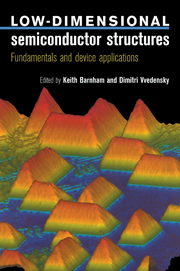Book contents
- Frontmatter
- Contents
- List of contributors
- Preface
- 1 Epitaxial Growth of Semiconductors
- 2 Electrons in Quantum Semiconductor Structures: An Introduction
- 3 Electrons in Quantum Semiconductors Structures: More Advanced Systems and Methods
- 4 Phonons in Low-dimensional Semiconductor Structures
- 5 Localization and Quantum Transport
- 6 Electronic States and Optical Properties of Quantum Wells
- 7 Non-Linear Optics in Low-dimensional Semiconductors
- 8 Semiconductor Lasers
- 9 Mesoscopic Devices
- 10 High-speed Heterostructure Devices
- Solutions to Selected Exercises
- Index
2 - Electrons in Quantum Semiconductor Structures: An Introduction
Published online by Cambridge University Press: 06 July 2010
- Frontmatter
- Contents
- List of contributors
- Preface
- 1 Epitaxial Growth of Semiconductors
- 2 Electrons in Quantum Semiconductor Structures: An Introduction
- 3 Electrons in Quantum Semiconductors Structures: More Advanced Systems and Methods
- 4 Phonons in Low-dimensional Semiconductor Structures
- 5 Localization and Quantum Transport
- 6 Electronic States and Optical Properties of Quantum Wells
- 7 Non-Linear Optics in Low-dimensional Semiconductors
- 8 Semiconductor Lasers
- 9 Mesoscopic Devices
- 10 High-speed Heterostructure Devices
- Solutions to Selected Exercises
- Index
Summary
Introduction
Electronics has progressed from the large to the small. In the process, intuitive ideas gained from the ordinary world of classical physics have had to give way to those of the entirely different world of quantum mechanics. When electronic processes are taking place in structures with sizes of the order of centimetres, or even microns, one can describe what is happening in a continuous way. By changing conditions very slightly, one can expect the results to show only very slight changes. When the physical size of the system becomes smaller, however, quantum mechanical effects become important. Typically, a small enough system will be able to have only a few discrete energies. This is the obvious difference between the continuous possibilities that appear to be available to the electrons making up a current in a wire, and the picture one must use to describe what an individual electron must be doing when it is bound to an individual atom making up that wire. In the latter case, one must talk about the possible discrete energy levels which are permitted.
This used to be a clear-cut division. Nature makes the quantum world, while people manufacture the wires. What is new, however, is that people can now make materials and structures which may be large on the scale of atoms, but which are small enough that the graininess that comes with quantum effects is crucial to understanding their behaviour.
- Type
- Chapter
- Information
- Low-Dimensional Semiconductor StructuresFundamentals and Device Applications, pp. 56 - 78Publisher: Cambridge University PressPrint publication year: 2001
- 3
- Cited by



